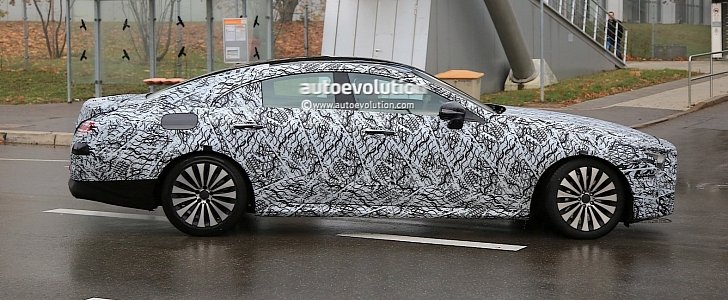Mercedes-Benz is working on the replacement of the CLS, which was the car that started the four-door coupe craze when its first generation came out.
The CLS was an impressively aerodynamic model when it was launched, and the German manufacturer has long focused on improving this aspect of its products. Including the G-Class, every model made by the three-pointed star brand was engineered to be as aerodynamic as possible. Evidently, the Gelandewagen gets a hall pass here, as its shape is more important than its drag coefficient.
With the next CLE, which is presumed to be the name of the CLS’s replacement, Mercedes-Benz has already employed sleek headlights. Those headlamps help the automaker reduce the profile of the front of the car, which is one of the most important elements when drag coefficient is concerned. From there, the sloped roof will also help reduce the friction with the air at speed, which further improves the air-cutting abilities of this model.
Mercedes-Benz has not announced a target value of the Cd of the next CLE, but it is believed that it will have an aerodynamic coefficient lower than 0.20. Back in the early 1990s, Opel surprised the world with the Calibra, which had a Cd of 0.26, the best value among series production cars of the time.
Meanwhile, Mercedes-Benz and other automakers bested that condition years ago. The 1.6-liter BlueEfficiency version of the Mercedes-Benz CLA achieved a 0.22 Cd, which is expected to be surpassed by the CLE.
At the time, Mercedes-Benz stated that it sold the world’s most aerodynamic production car, a statement that is true in spite of the existence of the Volkswagen XL1, which was a small volume model that had a better Cd value, but will not come close when production figures are concerned. The secret behind Mercedes-Benz’s small Cd numbers is its aeroacoustic wind tunnel in Sindelfingen, which can operate at speeds of up to 165 mph (265 km/h).
Two years ago, a concept vehicle revealed by Mercedes-Benz, the Concept IAA of 2015, had a Cd value of just 0.19. It was a four-door coupe, which leads everyone to think that the next CLE will try to emulate the figure when the MY 2019 comes to market.
With the next CLE, which is presumed to be the name of the CLS’s replacement, Mercedes-Benz has already employed sleek headlights. Those headlamps help the automaker reduce the profile of the front of the car, which is one of the most important elements when drag coefficient is concerned. From there, the sloped roof will also help reduce the friction with the air at speed, which further improves the air-cutting abilities of this model.
Mercedes-Benz has not announced a target value of the Cd of the next CLE, but it is believed that it will have an aerodynamic coefficient lower than 0.20. Back in the early 1990s, Opel surprised the world with the Calibra, which had a Cd of 0.26, the best value among series production cars of the time.
Meanwhile, Mercedes-Benz and other automakers bested that condition years ago. The 1.6-liter BlueEfficiency version of the Mercedes-Benz CLA achieved a 0.22 Cd, which is expected to be surpassed by the CLE.
At the time, Mercedes-Benz stated that it sold the world’s most aerodynamic production car, a statement that is true in spite of the existence of the Volkswagen XL1, which was a small volume model that had a better Cd value, but will not come close when production figures are concerned. The secret behind Mercedes-Benz’s small Cd numbers is its aeroacoustic wind tunnel in Sindelfingen, which can operate at speeds of up to 165 mph (265 km/h).
Two years ago, a concept vehicle revealed by Mercedes-Benz, the Concept IAA of 2015, had a Cd value of just 0.19. It was a four-door coupe, which leads everyone to think that the next CLE will try to emulate the figure when the MY 2019 comes to market.




































